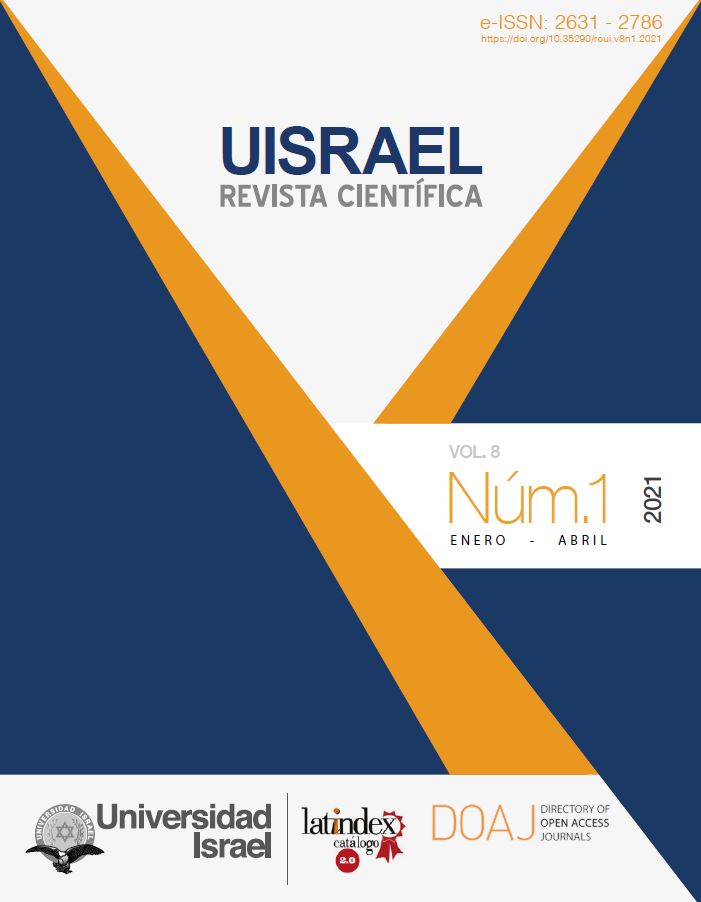La reinserción social post penitenciaria: un reto a la justicia ecuatoriana
DOI:
https://doi.org/10.35290/rcui.v8n1.2021.265Palabras clave:
reinserción, rehabilitación , post penitenciaría, penado, EcuadorResumen
Los seres humanos pueden reflejar sus bondades y miserias durante su vida, unas de esas miserias adquiridas por naturaleza o por aprendizaje social, en todo caso destructivas, pueden actuar como hilo conductor al delito. Como defensa contra el delito se crearon las penas y dentro de ellas, la prisión, cuya finalidad es que el ciudadano asuma una serie de valores básicos para la convivencia social en un régimen de democracia y justicia donde se respetan los derechos subjetivos y humanos. Esto significa que la pena debe estar fundamentada en políticas claves para la rehabilitación del individuo y su reinserción normal a la sociedad, lo que requiere un Estado que se preocupe no sólo por fijar las políticas, sino aplicarlas, hacerles seguimiento y evaluarlas para dejarlas, cambiarlas o eliminarlas. La presente investigación tiene como propósito analizar si es efectiva la reinserción social del penado en Ecuador, lo que se justifica por las exigencias constitucionales del Estado ecuatoriano. Para dar cumplimiento al objetivo del estudio se aplicó una metodología de carácter cuantitativa y cualitativa (mixta) en la que se unen estudios doctrinales y legales a la aplicación de una encuesta a los internos de la cárcel de Cotopaxi.
Descargas
Referencias
Congreso de las Naciones Unidas sobre la Prevención del Delito y Tratamiento del Delincuente. (2015). Las Reglas Mínimas de las Naciones Unidas para el tratamiento de los reclusos (Reglas Nelson Mandela). https://parlamento.gub.uy/sites/default/files/DocumentosCPP/Reglas%20Nelson%20Mandela.pdf
Ecuador Chequea. (2018). El hacinamiento se ha reducido en las cárceles. http://www.ecuadorchequea.com/2018/05/28/hacinamiento-carceles-ecuador-gobierno-leninmoreno/
Ecuador, Asamblea Constituyente. (2008). Constitución de la República de El Ecuador. Quito: Registro Oficial Nº 449 del lunes 20 de Octubre de 2008.
Ecuador, Asamblea Nacional. (2014). Código Orgánico Integral Penal. Quito: Registro Oficial Suplemento 180 de 10 de feb. 2014.
Ecuador, Asamblea Nacional. (2014, p.14). Código Orgánico Integral Penal. Quito: Registro Oficial Suplemento 180 de 10 de feb. 2014.
Ecuador, Ministerio de Justicia Derechos Humanos y Cultos. (2018) https://issuu.com/comisionjusticia/docs/ppt_final_asamblea_ministra_de_just
Mir Puig, S. (2002,p.3). Función de la pena y Teoría del Delito. Espasa Calpe: España.
Oficina del Alto Comisionado de las Naciones Unidas para los Derechos Humanos. (2005). Los Derechos Humanos y las Prisiones, Guía para el instructor en Derechos Humanos para funcionarios de prisiones. Ginebra: ONU. https://www.ohchr.org/Documents/Publications/training11Add2sp.pdf
Organización de Naciones Unidas. (2007). Recopilación de Reglas y Normas de las Naciones Unidas en la esfera de la Prevención del delito y la justicia penal. Viena: ONU. https://www.unodc.org/pdf/criminal_justice/Compendium_UN_Standards_and_Norms_CP_and_CJ_Spanish.pdf
Soler, S. (1992). Derecho Penal Argentino Tomo II. Buenos Aires: tea. http://www.academia.edu/28896423/Derecho_Penal_Argentino_Sebasti%C3%A1n_Soler_Tomo_I
Publicado
Número
Sección
Licencia
Derechos de autor 2021 Osvaldo P. Brito Febles y Byron Ramiro Alcocer Castillo

Esta obra está bajo una licencia internacional Creative Commons Atribución 4.0.
Los autores que participen de los procesos de evaluación y publicación de sus ediciones conservan los derechos de autor y ceden a la revista el derecho a la primera publicación, tal como establecen las condiciones de reconocimiento en la licencia Creative Commons Reconocimiento 4.0 Internacional (CC BY), donde los autores autorizan el libre acceso a sus obras, permitiendo que los lectores copien, distribuyan y transmitan por diversos medios, garantizando una amplia difusión del conocimiento científico publicado.
- Toda derivación, a partir de esta obra, deberá citar la fuente y a la primera publicación en esta revista. Se permiten derechos comerciales no lucrativos sobre sus contenidos.
- Los autores pueden realizar otros acuerdos contractuales independientes y adicionales para la distribución no exclusiva de la versión del artículo publicado en esta revista, es decir, podrán incluirlo en un repositorio institucional o publicarlo en un libro, siempre que indiquen claramente que el trabajo se publicó por primera vez en esta revista.
- Se permite y recomienda a los autores compartir su trabajo en línea, con la finalidad de intercambios productivos para una mayor y más rápida citación del trabajo como lo establece los efectos del movimiento ‘Acceso Abierto’.
- No puede aplicar términos legales o medidas tecnológicas que restrinjan legalmente a otros de hacer cualquier cosa que permita la licencia: https://creativecommons.org/licenses/by/4.0/deed.es
- La Revista Científica es financiada completamente de los aportes realizados por nuestra entidad editora: Universidad Tecnológica Israel; por tal motivo, no establece cargos o cobros de ninguna índole a sus autores y colaboradores, así como tampoco genera pagos o remuneraciones de ningún tipo a ellos.
- Se asignará un Digital Object Identifier (DOI) a cada publicación.







